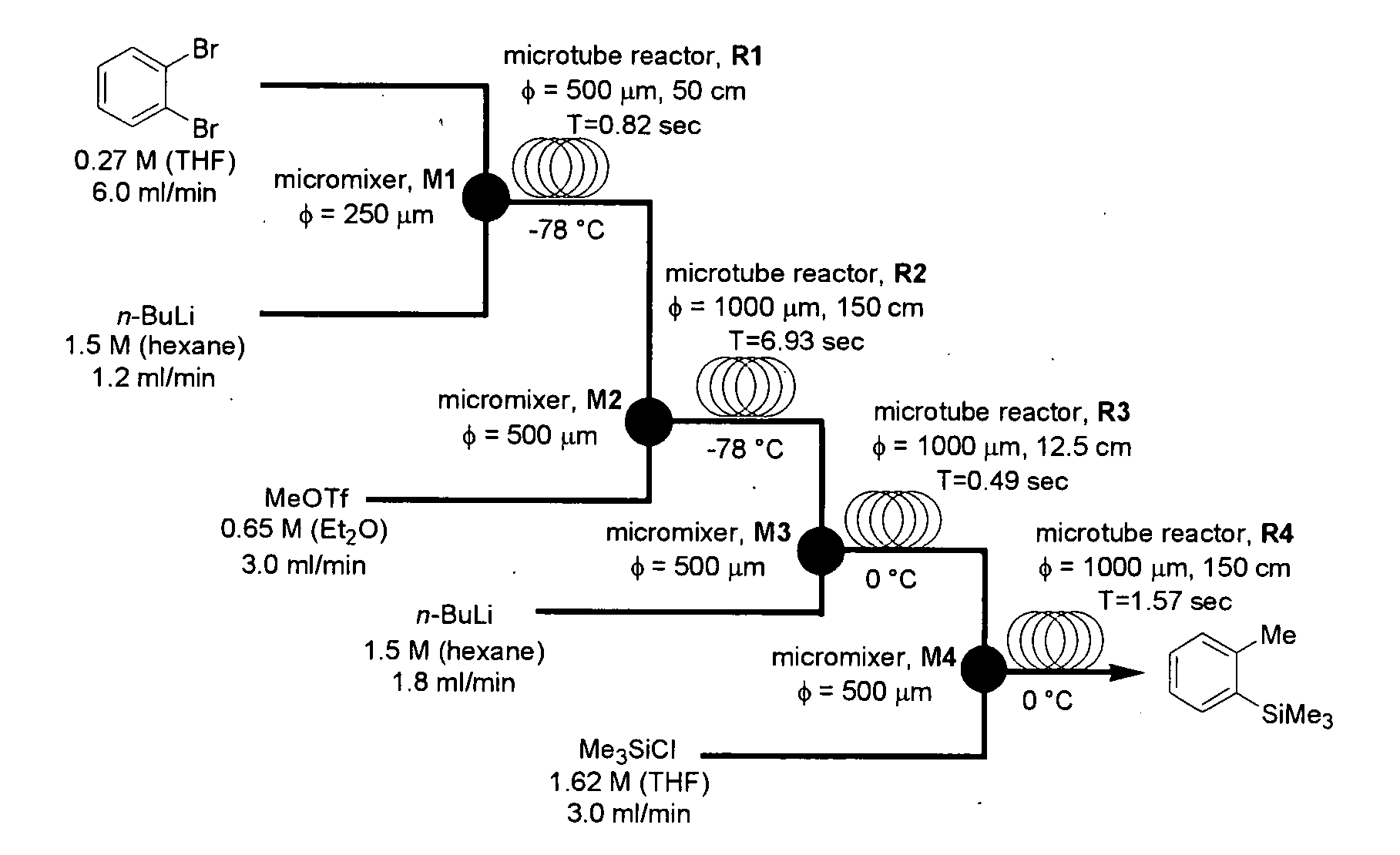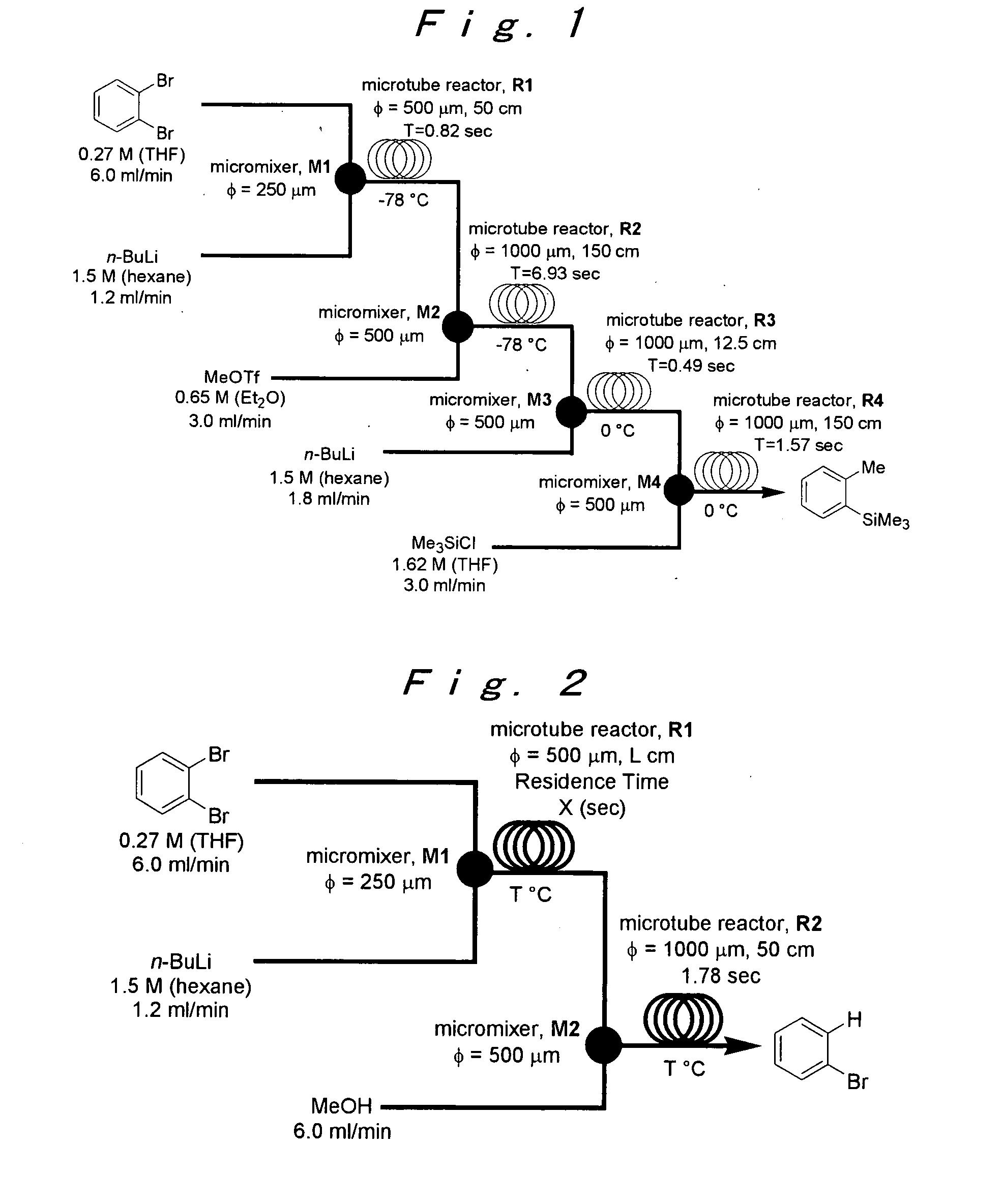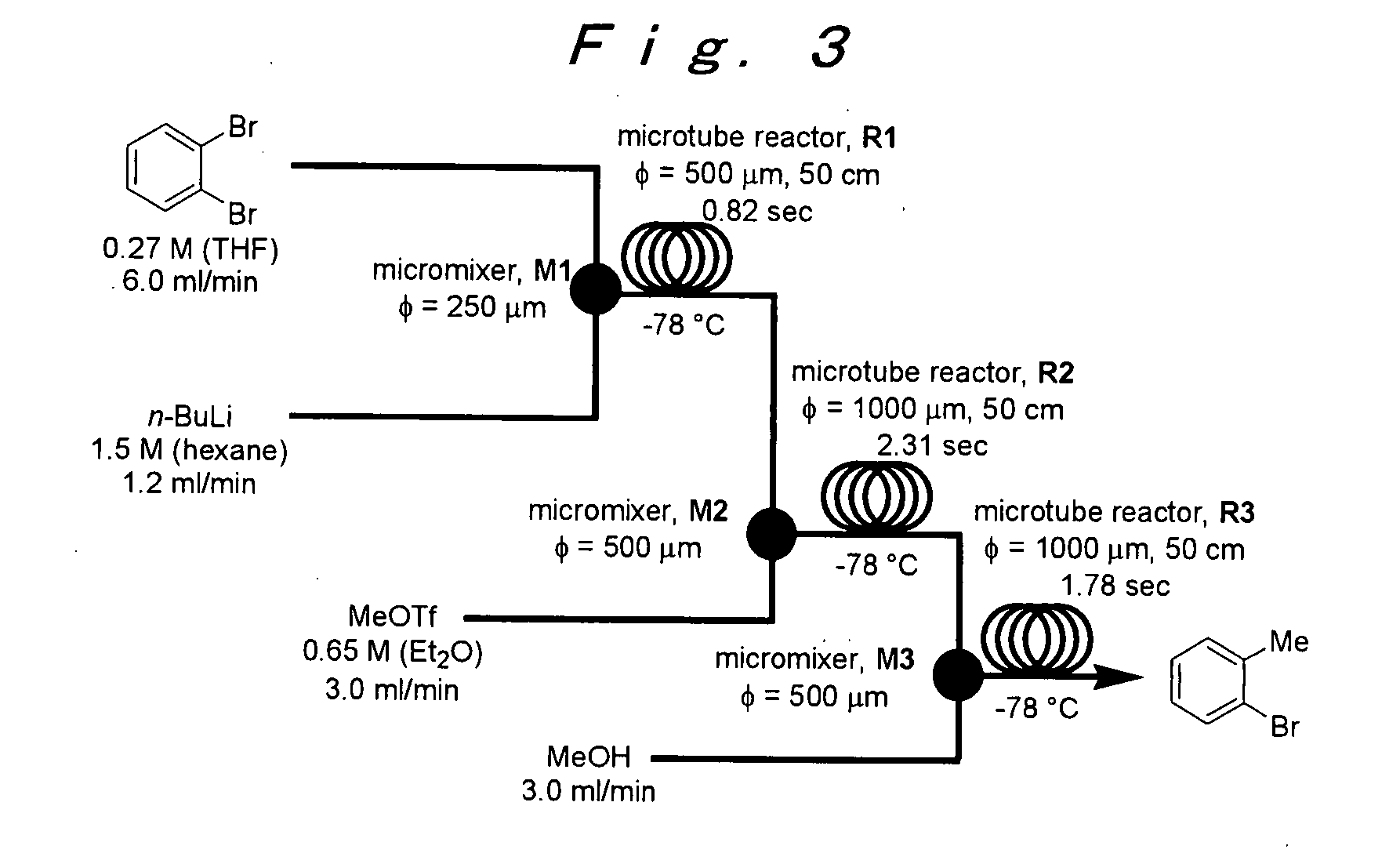Method of producing an o-disubstituted aromatic compound, and method of producing a monosubstituted-monohaloaromatic compound
a monosubstituted, aromatic compound technology, applied in the direction of organic chemistry, chemistry apparatus and processes, compound preparation of oxygen-containing compounds, etc., can solve the problem of difficult reaction of the above-described lithiated compound with the electrophilic compound
- Summary
- Abstract
- Description
- Claims
- Application Information
AI Technical Summary
Benefits of technology
Problems solved by technology
Method used
Image
Examples
example 1
[0103]The present invention was carried out using a microreactor apparatus, as shown in FIG. 1.
[0104]A microsystem composed of four T-shaped micromixers (M1, M2, M3 and M4) and four microtube reactors (R1, R2, R3 and R4) was used. The M1, R1, M2 and R2 were dipped in a cooling bath (−78° C.), and the M3, R3, M4 and R4 were dipped in a cooling bath (0° C.). A reaction solution flowed from R4 was cooled at 0° C., and was collected in a flask. A solution of o-dibromobenzene (0.27 M) in THF (flow rate: 6 mL / min, 1.62 mmol / min) and a solution of n-BuLi (1.5 M) in n-hexane (flow rate: 1.2 mL / min, 1.8 mmol / min) were introduced to the first T-shaped mixer M1 (inner diameter: 250 μm) by using syringe pumps. A solution of methyl trifluoromethanesulfonate (MeOTf) (0.65 M) in THF (flow rate: 3 mL / min, 1.95 mmol / min) was introduced to the second T-shaped mixer M2 (inner diameter: 500 μm). A solution of n-BuLi (1.5 M) in n-hexane (flow rate: 1.8 mL / min, 2.7 mmol / min) was introduced to the third T...
example 2
[0105]The microreactor apparatus same as shown in FIG. 1 was used.
[0106]A microsystem composed of four T-shaped micromixers (M1, M2, M3 and M4) and four microtube reactors (R1, R2, R3 and R4) was used. The M1, R1, M2 and R2 were dipped in a cooling bath (−78° C.), and the M3, R3, M4 and R4 were dipped in a cooling bath (0° C.). A reaction solution flowed from R4 was cooled at 0° C., and was collected in a flask. A solution of o-dibromobenzene (0.27 M) in THF (flow rate: 6 mL / min, 1.62 mmol / min) and a solution of n-BuLi (1.5 M) in n-hexane (flow rate: 1.2 mL / min, 1.8 mmol / min) were introduced to the first T-shaped mixer M1 (inner diameter: 250 μm) by using syringe pumps. A solution of methyl trifluoromethanesulfonate (0.65 M) in THF (flow rate: 3 mL / min, 1.95 mmol / min) was introduced to the second T-shaped mixer M2 (inner diameter: 500 μm). A solution of n-BuLi (1.5 M) in n-hexane (flow rate: 1.8 mL / min, 2.7 mmol / min) was introduced to the third T-shaped mixer M3 (inner diameter: 500...
example 3
[0107]The microreactor apparatus same shown in FIG. 1 was used.
[0108]A microsystem composed of four T-shaped micromixers (M1, M2, M3 and M4) and four microtube reactors (R1, R2, R3 and R4) was used. The M1, R1, M2 and R2 were dipped in a cooling bath (−78° C.), and the M3, R3, M4 and R4 were dipped in a cooling bath (0° C.). A reaction solution flowed from R4 was cooled at 0° C., and was collected in a flask. A solution of o-dibromobenzene (0.27 M) in THF (flow rate: 6 mL / min, 1.62 mmol / min) and a solution of n-BuLi (1.5 M) in n-hexane (flow rate: 1.2 mL / min, 1.8 mmol / min) were introduced to the first T-shaped mixer M1 (inner diameter: 250 μm) by using syringe pumps. A solution of methyl trifluoromethanesulfonate (0.65 M) in THF (flow rate: 3 mL / min, 1.95 mmol / min) was introduced to the second T-shaped mixer M2 (inner diameter: 500 μm). A solution of n-BuLi (1.5 M) in n-hexane (flow rate: 1.8 mL / min, 2.7 mmol / min) was introduced to the third T-shaped mixer M3 (inner diameter: 500 μm...
PUM
| Property | Measurement | Unit |
|---|---|---|
| temperature | aaaaa | aaaaa |
| length | aaaaa | aaaaa |
| length | aaaaa | aaaaa |
Abstract
Description
Claims
Application Information
 Login to View More
Login to View More - R&D
- Intellectual Property
- Life Sciences
- Materials
- Tech Scout
- Unparalleled Data Quality
- Higher Quality Content
- 60% Fewer Hallucinations
Browse by: Latest US Patents, China's latest patents, Technical Efficacy Thesaurus, Application Domain, Technology Topic, Popular Technical Reports.
© 2025 PatSnap. All rights reserved.Legal|Privacy policy|Modern Slavery Act Transparency Statement|Sitemap|About US| Contact US: help@patsnap.com



